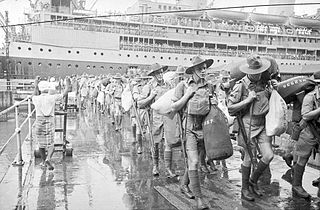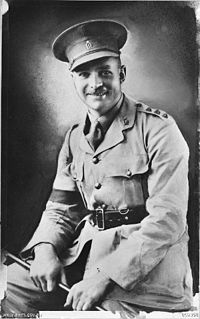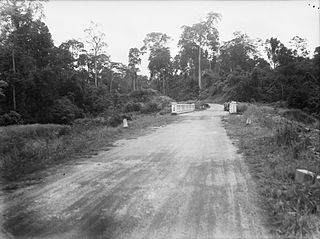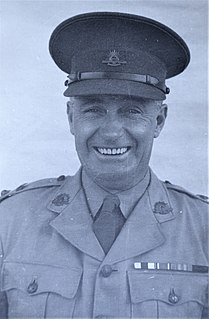
The 8th Division was an infantry division of the Australian Army, formed during World War II as part of the all-volunteer Second Australian Imperial Force. The 8th Division was raised from volunteers for overseas service from July 1940 onwards. Consisting of three infantry brigades, the intention had been to deploy the division to the Middle East to join the other Australian divisions, but as war with Japan loomed in 1941, the division was divided into four separate forces, which were deployed in different parts of the Asia-Pacific region. All of these formations were destroyed as fighting forces by the end of February 1942 during the fighting for Singapore, and in Rabaul, Ambon, and Timor. Most members of the division became prisoners of war, waiting until the war ended in late 1945 to be liberated. One in three died in captivity.

The Japanese 25th Army was an army of the Imperial Japanese Army during World War II, noted for its role in the Malayan Campaign and the Battle of Singapore.

The 2/18th Battalion was an Australian Army infantry unit that served during World War II. Formed in June 1940, the battalion was assigned to the 22nd Brigade, which formed part of the Australian 8th Division. After completing basic training, the 2/18th was sent to Singapore and Malaya to strengthen the defences of the British colonies in February 1941 against a possible Japanese attack. The 2/18th Battalion subsequently undertook garrison duties throughout the year at various locations in Malaya, where it conducted jungle training and constructed defences along the eastern coast.

The Battle of Muar was the last major battle of the Malayan Campaign during the Second World War. It took place from 14–22 January 1942 around Gemensah Bridge and on the Muar River. After the British defeat at Slim River, General Archibald Wavell, commander of ABDA, decided that Lieutenant General Lewis Heath's III Indian Corps should withdraw 240 kilometres (150 mi) south into the State of Johore to rest and regroup, whilst the 8th Australian Division would attempt to stop the Japanese advance.

Lionel Colin Matthews, was an Australian Army officer in World War II. He was posthumously awarded the George Cross, the highest award for heroism or courage not in the face of the enemy, that could be awarded to a member of the Australian armed forces at the time. Matthews was born in Adelaide, South Australia, and was schooled there before moving to Victoria. He trained as a signalman in the Royal Australian Naval Reserve before joining the Militia in April 1939. Commissioned as an officer in the Australian Corps of Signals, Matthews transferred to the 8th Division of the Second Australian Imperial Force after the outbreak of World War II.
Brigadier Duncan Stuart Maxwell, MC, also known as Duncan Struan Maxwell, was a medical practitioner and an Australian Army officer who served in the First and the Second World Wars. He was commander of the 27th Brigade during the Japanese invasion of Malaya and the Battle of Singapore in the Second World War.

The Battle of Gemas—part of the wider Battle of Muar—took place during the Japanese invasion of Malaya in the Pacific Campaign of the Second World War. The action occurred on 14 January 1942 at the Gemencheh Bridge near Gemas and saw around 1,000 troops of the Japanese 5th Division killed or wounded during a fierce ambush initiated by Australian soldiers from 2/30th Battalion, assigned to the 27th Brigade of the 8th Division.
The 27th Brigade was a brigade-sized infantry unit of the Australian Army. The brigade was the last Second Australian Imperial Force infantry brigade raised for service during World War II. Initially assigned to the 9th Division, the brigade was transferred to the 8th Division shortly after it was raised. Training was undertaken around Bathurst, New South Wales throughout early 1941, before the brigade was sent to British Malaya in August 1941 to reinforce the 22nd Brigade, which had been dispatched earlier in the year. Following the Japanese invasion of Malaya, the brigade went into action in January 1942, taking part in the fighting along the western side of the Malay Peninsula. Its main action during this period came around Muar before the withdrawal to Singapore. In February, the brigade took part in the short lived Battle of Singapore. When the garrison surrendered on 15 February, the majority of the brigade's personnel were taken prisoner. They subsequently spent the remainder of the war in captivity before being released in August 1945.

The 22nd Brigade was a brigade-sized infantry unit of the Australian Army. It was briefly raised in 1912 as a Militia formation providing training as part of the compulsory training scheme. Later, during World War II, the brigade was raised as part of the all volunteer Second Australian Imperial Force in April 1940. Assigned to the 8th Division, in early 1941 the brigade was deployed to British Malaya where it formed part of the defensive garrison that was established there by the British, eventually establishing its headquarters in the Mersing–Endau area.

The 2/26th Battalion was an infantry battalion of the Australian Army. Raised in late 1940 for service during the Second World War, the battalion undertook garrison duties in Malaya and Singapore prior to the start of the Pacific War. In 1941–42, following the Japanese invasion of Malaya, the battalion fought during the Malayan campaign. After the fall of the island, however, many of its soldiers became prisoners of war, remaining in captivity until being liberated at the end of the war in 1945. The battalion was never re-raised.

The 2/4th Machine Gun Battalion was an Australian Army unit raised for service with the all volunteer Second Australian Imperial Force during the Second World War. Formed in late 1940 as part of the 8th Division, the battalion was established to provide direct fire support to the division's infantry brigades. It was the fourth, and last, such unit raised within the 2nd AIF. The unit's personnel were largely drawn from the state of Western Australia and after formation, the battalion concentrated near Perth for basic individual training before moving to the Adelaide Hills to complete more advance manouevres.
The 2nd Malaya Infantry Brigade was a regular infantry brigade formed in 1940 with its headquarters in Singapore following the wartime expansion and reinforcement of Malaya Command. The Brigade participated in the Malayan Campaign and the Battle of Singapore against the Japanese until the surrender of the garrison in February 1942.

The 2/29th Battalion was an infantry battalion of the Australian Army, which served during the Second World War. Formed in October 1940, the battalion served in Malaya as part of the 27th Brigade, which was assigned to the 8th Division. Recruited mainly from volunteers drawn from the state of Victoria, after completing its training around Bonegilla and then Bathurst, the 2/29th Battalion was sent to Malaya in August 1941 along with the rest of the 27th Brigade to bolster the Australian force there and subsequently fought in the Malayan Campaign following the Japanese attack in December 1941. The battalion fought several delaying actions along the west coast, including fighting around Bakri and Muar, and in Johore, before Allied forces withdrew across the Causeway to Singapore. The battalion later took part in the defence of Singapore in February 1942, but was captured after the garrison capitulated on 15 February. They spent the remainder of the war as prisoners of war, with many dying in captivity.

Major General Sir Frederick Gallagher Galleghan, was a senior officer in the Australian Army who served in the First and Second World Wars.

The 2/19th Battalion was an infantry battalion of the Australian Army, which was raised for service during the Second World War as part of the Second Australian Imperial Force. After being formed in mid-1940, the battalion was allocated to the 22nd Brigade, which was part of the 8th Division. After completing training in Australia, in early 1941 the 2/19th deployed to Malaya, as part of the Australian force despatched to help bolster the British garrison there as tensions with Japan heightened. Following the commencement of hostilities against Japan, the 2/19th fought several actions in Johore, before withdrawing across the Causeway to Singapore. There, the battalion was involved in the Battle of Singapore in early February 1942, during which it suffered heavy casualties before being captured following the capitulation of the British garrison. The battalion's personnel subsequently spent the next three-and-a-half years as prisoners of war, before being released at the end of the conflict.

The 2/20th Battalion was an infantry battalion of the Australian Army. Raised in mid-1940 as part of the 8th Division, the battalion was recruited from Second Australian Imperial Force volunteers drawn from the state of New South Wales. In early 1941, the 2/20th Battalion deployed to Malaya, where they formed part of the garrison there until December when the Japanese invaded. The battalion subsequently fought a brief campaign along the east coast of the Malay Peninsula before being withdrawn back to Singapore in early 1942. They were heavily engaged after the Japanese landed on the island, and were eventually captured following the Fall of Singapore. Most members of the battalion became prisoners of war, and a large number died in captivity.
The 2/15th Field Regiment was an Australian Army field artillery regiment that served during the Second World War. Raised in late 1940 as part of the Second Australian Imperial Force, the regiment was assigned to the 8th Division. In late 1941, it was sent to Singapore and subsequently fought in the Malayan Campaign before being captured after the Fall of Singapore.
The 2/21st Battalion was an infantry battalion of the Australian Army. Raised for service during Second World War as part of the Second Australian Imperial Force, it was formed on 11 July 1940 at Trawool in central Victoria as part of the 23rd Brigade of the 8th Division. It was subsequently deployed to Ambon as part of Gull Force in December 1941 following the Japanese invasion of Malaya; however, with the defence of the island considered untenable due to the limited military resources available and overwhelming Japanese strength it was subsequently captured despite determined resistance, surrendering on 3 February 1942. Most members of the battalion became prisoners of war, and a large number died in captivity.

Lieutenant Colonel John Charles Robertson was a senior officer in the Australian Army who served in both the First and Second World Wars.

The 2/4th Anti-Tank Regiment was an Australian Army anti-tank artillery regiment that was raised for service during the Second World War as part of the all volunteer Second Australian Imperial Force. It was formed in November 1940, and was assigned to the 8th Division. In early 1942, the regiment took part in the Malayan campaign and the Battle of Singapore before being captured when Singapore fell to the Japanese at which time most of its personnel became prisoners of war. Over 170 members of the regiment died in captivity before the end of the war in August 1945.















